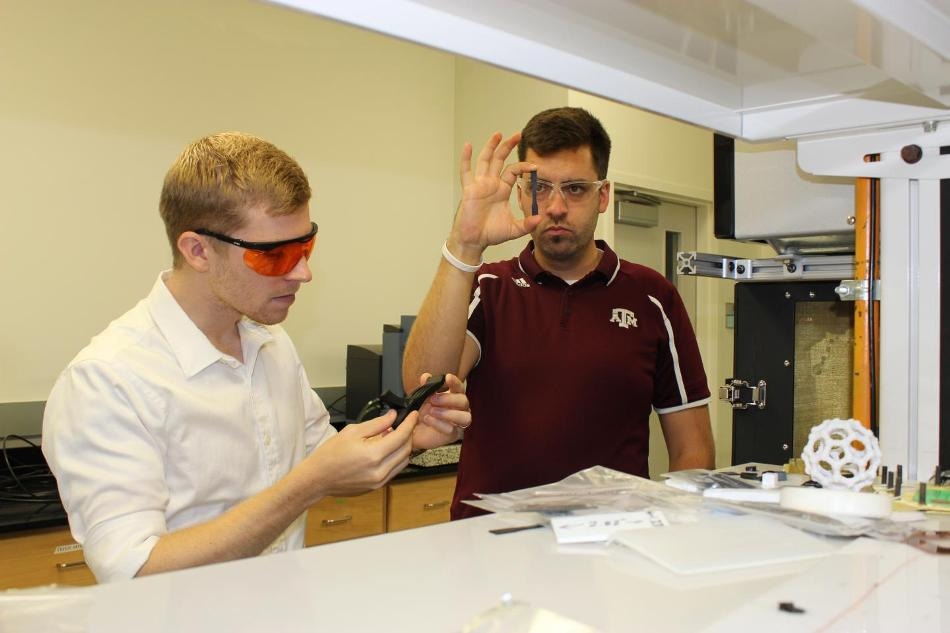Jul 24 2017
3D-printed parts are used in a range of industries varying from defense and aerospace to digital dentistry and medical devices. At present, 3D-printed parts are very delicate and are conventionally used as a toy for display or in the prototyping phase of materials.
A corrective measure to transform the landscape of today’s 3D printing has been pioneered by a Doctoral Student in the Department of Materials Science and Engineering at Texas A&M University.
 Brandon Sweeney and Blake Tiepel working in the lab. (Credit: Texas A&M University)
Brandon Sweeney and Blake Tiepel working in the lab. (Credit: Texas A&M University)
An innovative way to make 3D-printed parts stronger and instantly useful in real-world applications has been discovered by Brandon Sweeney and his Advisor Dr. Micah Green, Associate Professor in the Department of Chemical Engineering. Green and Sweeney implemented the conventional welding concepts to bond the sub millimeter layers in a 3D-printed part together, while in a microwave.
While working at the Army Research Laboratory at the Aberdeen Proving Grounds in Maryland, Sweeney began working with 3D-printed materials.
I was able to see the amazing potential of the technology, such as the way it sped up our manufacturing times and enabled our CAD designs to come to life in a matter of hours. Unfortunately, we always knew those parts were not really strong enough to survive in a real-world application.
Brandon Sweeney, Doctoral Student, the Department of Materials Science and Engineering, Texas A&M University
3D-printed objects are made up of many thin layers of materials, plastics in this case, that are deposited on top of each other to form the required shape. When employed in a real-world application, these layers are subjected to fracturing, causing issues with the reliability and durability of the part. For instance a custom printed medical device is one such application.
I knew that nearly the entire industry was facing this problem. Currently, prototype parts can be 3D printed to see if something will fit in a certain design, but they cannot actually be used for a purpose beyond that.
Brandon Sweeney, Doctoral Student, the Department of Materials Science and Engineering, Texas A&M University
Sweeney was working with Green in the Department of Chemical Engineering at Texas Tech University, when he started his doctorate. Green had been working with Dr. Mohammad Saed, Assistant Professor in the Electrical and Computer Engineering Department at Texas Tech, on a project to identify carbon nanotubes using microwaves. The trio came up with an idea to use carbon nanotubes in 3D-printed parts, together with microwave energy to weld the layers of parts together.
“The basic idea is that a 3D part cannot simply be stuck into an oven to weld it together because it is plastic and will melt,” Sweeney said. “We realized that we needed to borrow from the concepts that are traditionally used for welding parts together where you’d use a point source of heat, like a torch or a TIG welder to join the interface of the parts together. You’re not melting the entire part, just putting the heat where you need it.”
Special materials are employed to control where the heat hits and bonds the layers together, as the layers making up the 3D-printed parts are so minute.
What we do is take 3D printer filament and put a thin layer of our material, a carbon nanotube composite, on the outside. When you print the parts out, that thin layer gets embedded at the interfaces of all the plastic strands. Then we stick it in a microwave, we use a bit more of a sophisticated microwave oven in this research, and monitor the temperature with an infrared camera.
Brandon Sweeney, Doctoral Student, the Department of Materials Science and Engineering, Texas A&M University
Essentium Materials, a local company, patent-pends and licenses the technology. The materials are manufactured in-house, where they also specifically develop the printer technology to integrate the electromagnetic welding process into the 3D printer itself. The welding takes place at the same time, while the part is being printed. Although, they are presently in beta mode, this has the capability to be on every consumer and industrial 3D printer where powerful parts are required.
“If you're an engineer and if you actually care about the mechanical properties of what you're making, then this ideally would be on every printer in that category,” Sweeney said.
Recently in Science Advances, the team published a paper “Welding of 3D-Printed Carbon Nanotube-Polymer Composites by Locally Induced Microwave Heating”.
Team develops stronger 3-D printed parts